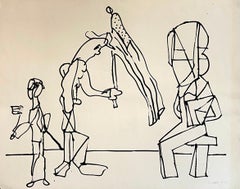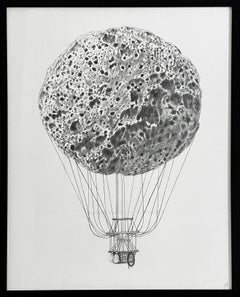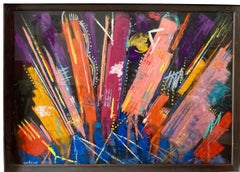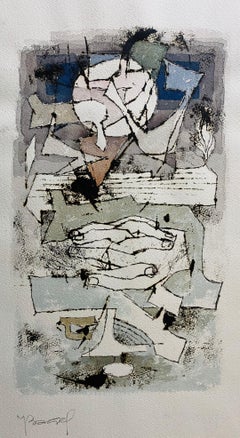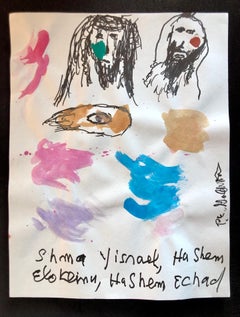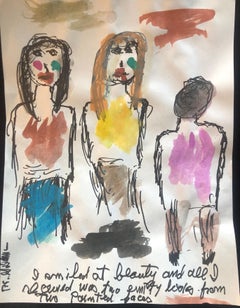Florida - Abstract Drawings and Watercolors
1970s Abstract Expressionist Florida - Abstract Drawings and Watercolors
Ink, Watercolor
2010s Abstract Florida - Abstract Drawings and Watercolors
Cardboard, Graphite
Mid-20th Century Abstract Expressionist Florida - Abstract Drawings and Watercolors
Paper, Oil Pastel
20th Century Modern Florida - Abstract Drawings and Watercolors
Ink, Watercolor, ABS
21st Century and Contemporary American Realist Florida - Abstract Drawings and Watercolors
Paper, Watercolor
21st Century and Contemporary Neo-Expressionist Florida - Abstract Drawings and Watercolors
Paper, Watercolor
21st Century and Contemporary Neo-Expressionist Florida - Abstract Drawings and Watercolors
Paper, Watercolor
20th Century Modern Florida - Abstract Drawings and Watercolors
Ink, Watercolor, ABS
2010s Pop Art Florida - Abstract Drawings and Watercolors
Acrylic, Watercolor, Archival Paper
20th Century Modern Florida - Abstract Drawings and Watercolors
Watercolor, Lithograph
20th Century Contemporary Florida - Abstract Drawings and Watercolors
Acrylic, Watercolor, Gouache
20th Century Modern Florida - Abstract Drawings and Watercolors
Watercolor, Lithograph
21st Century and Contemporary American Realist Florida - Abstract Drawings and Watercolors
Paper, Watercolor
20th Century Modern Florida - Abstract Drawings and Watercolors
Ink, Watercolor, ABS
1950s Abstract Expressionist Florida - Abstract Drawings and Watercolors
Watercolor
21st Century and Contemporary Neo-Expressionist Florida - Abstract Drawings and Watercolors
Paper, Watercolor
21st Century and Contemporary Contemporary Florida - Abstract Drawings and Watercolors
Mixed Media, Synthetic Paper
21st Century and Contemporary American Realist Florida - Abstract Drawings and Watercolors
Paper, Watercolor
2010s Abstract Florida - Abstract Drawings and Watercolors
Canvas, Graphite
2010s Abstract Florida - Abstract Drawings and Watercolors
Watercolor, Cardboard
20th Century Abstract Expressionist Florida - Abstract Drawings and Watercolors
Paper, Charcoal, Watercolor, Gouache
1970s Modern Florida - Abstract Drawings and Watercolors
Watercolor, Lithograph
Late 20th Century Abstract Florida - Abstract Drawings and Watercolors
Paper, Ink
1980s Abstract Expressionist Florida - Abstract Drawings and Watercolors
Watercolor, Woodcut
2010s Abstract Florida - Abstract Drawings and Watercolors
Watercolor, Cardboard
2010s Abstract Florida - Abstract Drawings and Watercolors
Watercolor, Cardboard
20th Century Modern Florida - Abstract Drawings and Watercolors
Watercolor, Lithograph
20th Century Modern Florida - Abstract Drawings and Watercolors
Watercolor
2010s Modern Florida - Abstract Drawings and Watercolors
Paper, Acrylic
20th Century Modern Florida - Abstract Drawings and Watercolors
Ink, Watercolor
2010s Surrealist Florida - Abstract Drawings and Watercolors
Paper, Ink, Watercolor
Mid-20th Century Abstract Expressionist Florida - Abstract Drawings and Watercolors
Crayon, Pastel
1990s Abstract Florida - Abstract Drawings and Watercolors
Paper, Gouache
2010s Contemporary Florida - Abstract Drawings and Watercolors
Paper, Mixed Media, Charcoal, Oil Pastel, Pastel, Carbon Pencil
Mid-20th Century Abstract Florida - Abstract Drawings and Watercolors
Crayon, Oil Pastel
2010s Contemporary Florida - Abstract Drawings and Watercolors
Paper, Acrylic
Mid-20th Century Expressionist Florida - Abstract Drawings and Watercolors
Paper, Watercolor
20th Century Modern Florida - Abstract Drawings and Watercolors
Paper, Pastel
1980s 85 New Wave Florida - Abstract Drawings and Watercolors
Conté, Charcoal, Gouache, Rag Paper, Graphite
Early 20th Century Modern Florida - Abstract Drawings and Watercolors
Paper, Tempera
1980s Abstract Florida - Abstract Drawings and Watercolors
Chalk, Charcoal
20th Century Conceptual Florida - Abstract Drawings and Watercolors
Mixed Media, Monoprint, Monotype
20th Century Abstract Florida - Abstract Drawings and Watercolors
Watercolor, Archival Paper
1970s Surrealist Florida - Abstract Drawings and Watercolors
Lithograph, Offset
Early 2000s Abstract Expressionist Florida - Abstract Drawings and Watercolors
Paper, Ink, Watercolor, Permanent Marker
Early 2000s Abstract Expressionist Florida - Abstract Drawings and Watercolors
Paper, Ink, Watercolor, Permanent Marker
Early 2000s Abstract Expressionist Florida - Abstract Drawings and Watercolors
Paper, Ink, Watercolor, Permanent Marker
20th Century Conceptual Florida - Abstract Drawings and Watercolors
Mixed Media, Monoprint, Monotype
20th Century Conceptual Florida - Abstract Drawings and Watercolors
Mixed Media, Monoprint, Monotype
1960s Abstract Expressionist Florida - Abstract Drawings and Watercolors
Paper, Watercolor
Mid-20th Century Abstract Expressionist Florida - Abstract Drawings and Watercolors
Watercolor
Mid-20th Century Abstract Expressionist Florida - Abstract Drawings and Watercolors
Watercolor
21st Century and Contemporary Contemporary Florida - Abstract Drawings and Watercolors
Paper, Watercolor
1920s Post-Impressionist Florida - Abstract Drawings and Watercolors
Paper, Crayon
20th Century Conceptual Florida - Abstract Drawings and Watercolors
Mixed Media, Monoprint, Monotype
20th Century Abstract Florida - Abstract Drawings and Watercolors
Pencil, Color Pencil
1960s Florida - Abstract Drawings and Watercolors
Paper, India Ink
2010s Abstract Florida - Abstract Drawings and Watercolors
Charcoal
2010s Pop Art Florida - Abstract Drawings and Watercolors
Acrylic, Watercolor, Archival Paper
Mid-20th Century Contemporary Florida - Abstract Drawings and Watercolors
Paper, Color Pencil
